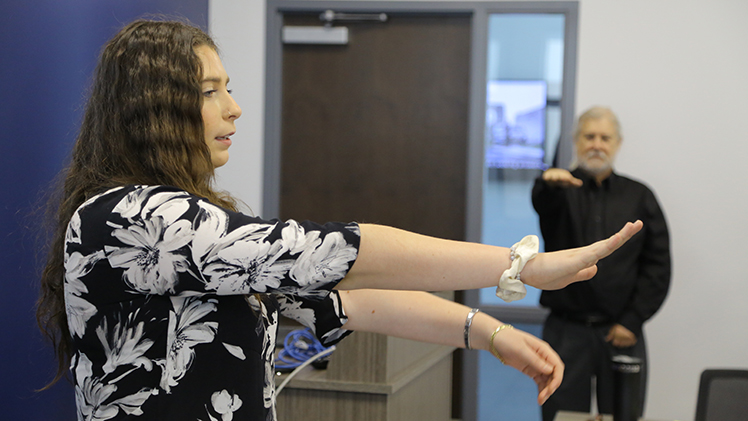Though law enforcement is an inherently dangerous job, police officers are more likely to die by suicide than they are from criminal activity.
“We often think of the bad guy with a gun harming our police officers, and of course that does happen, but one of the leading causes of death for law enforcement officers is suicide,” said Dr. Wesley Bullock, an associate professor of psychology at The University of Toledo.

Elena Canini, a clinical psychology doctoral student, left, and Dr. Wesley Bullock, an associate professor of psychology, lead UToledo Police officers in mindfulness exercises as part of a training and research project.
A 2021 study published in the journal Policing found U.S. law enforcement officers are 54% more likely to die by suicide than the average American.
The pressure and high-intensity nature of the job can also manifest in other ways. Multiple studies have shown, for example, that police officers also are more likely to develop cardiovascular disease than individuals in other professions.
“It’s an incredibly stressful job,” Bullock said. “Policing takes a toll on the body, on the heart, and of course it also takes a mental, emotional and psychological toll as well.”
A novel partnership between Bullock’s lab and the UToledo Police Department aims to provide officers with tools to reduce anxiety and manage stress, leading to healthier officers and more effective policing.
This summer, a small number of UToledo Police officers were given the opportunity to take part in a six-week mindfulness-based stress reduction program. A new group of officers are completing the mindfulness program this fall.
“Clearly we have to do something different to take care of our police officers and first responders,” said Jeff Newton, associate vice president of public safety. “One of the biggest killers of police officers is cardiac issues. The stress and the trauma — they’re taking a toll on the profession. This is a great opportunity to collaborate with an academic department, providing important research data for them and a great benefit for us.”
At its most basic level, Bullock describes mindfulness as “paying attention, on purpose, to the present moment, nonjudgmentally.”
The course provides an overview of how the mind and body are linked and how the mind-body responds to stress and trauma.
Officers learn and practice a variety of mindfulness skills and meditation practices, such as mindful breathing, that they can employ to better manage high-intensity moments on the job.
“Really I think of them as technologies of mindfulness, and how these technologies can help to both protect against stress and provide resilience when you have stresses that you can’t avoid,” Bullock said.
While Bullock has taught mindfulness to a diverse array of groups — from inmates at the Toledo Correctional Institution to students at UToledo — this is the first time he’s worked directly with law enforcement.
He and his team started the process by doing ride-alongs with officers to get a first-hand perspective of their day-to-day life and better understand how and when stressful situations come about.
Newton said those efforts helped to build trust and rapport within the department and that there’s been enthusiastic buy-in from his officers.
“Wes has a great delivery style, he’s trustworthy and he’s a great presenter,” he said. “We were looking at bolstering our officer wellness initiatives and this program came out at exactly the right time. I think there will be benefits to this on duty and off duty. You have to have a holistic approach to wellness.”
In addition to health benefits, Newton said he believes a mindful approach to law enforcement leads to better outcomes in the field.
“Emotional awareness and a nonjudgmental mindset are important factors for an officer to achieve the best resolution to a call for service,” he said.
Bullock and his laboratory team of UToledo students are gathering data that can be used to measure the effectiveness of mindfulness-based stress reduction for law enforcement and hopefully help in developing a template that can benefit law enforcement agencies across the region.
On-duty officers wore heart monitors prior to the program’s launch to provide a baseline measure of their cardiac function. Follow-up data are being collected after the training program is complete.
Officers also complete standardized surveys to measure symptoms of stress, anxiety and depression to assess both the benefits of the program and how long those benefits appear to last.
“One of the things we measure as an outcome is whether the officers are learning and practicing these mindfulness skills,” Bullock said. “We’re not trying to replace their training as law enforcement officers. What we want to do is increase their ability to stay grounded, see things clearly and better manage the stress and trauma that comes with the job.”